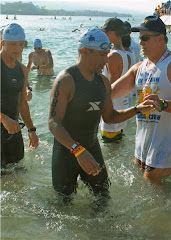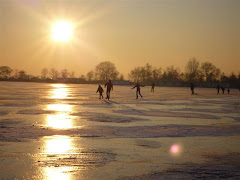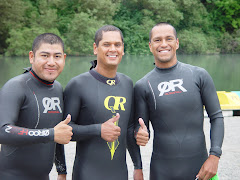 During Training Camp last Saturday Jimmy told us about his encounter with a Stingray off the coast of La Jolla Shores and I thought I would enter this little blurb to read up on, just in case. If you ever get stung, you'll know what to do.
During Training Camp last Saturday Jimmy told us about his encounter with a Stingray off the coast of La Jolla Shores and I thought I would enter this little blurb to read up on, just in case. If you ever get stung, you'll know what to do."The Stingray"
The reason stingrays are dangerous is because of the rather large poisonous spine located on their tail. This spine is hard and very sharp and is used to pierce the hard outer covering of shellfish which makes up a large portion of the stingray's diet. This sharp spine can grow to over 12 inches long in some species and because of these dangerous spines and the poison it injects, stingrays are often avoided by all but the hungriest fishermen. Several swimmers have been killed after being struck by the poisonous spines and neglecting to get immediate medical attention.
"What to do if wounded by a Stingray"
If wounded by a stingray, get out of the water immediately. Remove any part of the spine that may remain in the wound and apply hot water to the affected area as soon as possible. The temperature should be around 95-105 degrees fahrenheit which will be hot enough to detoxify the poison but not to cause burns. The wound should be treated with hot water for 1 to 1 1/2 hours. The wound should then be irrigated with an anesthetic such as lidocaine (lignocaine) or longer lasting bupivacaine. This will help deal with the pain until the wound starts to heal. It is a good idea to check the wound for fragments of spine which may still remain..remove all fragments, apply an antibiotic cream, and bandage the wound.
Stingrays often weigh 650-750 lbs and are 14-16 ft. in length, including the tail. They mate from March to late September or early October and lay 2-8 eggs with the normal amount being 2-5. The gestation period is from April to late August. The lifespan of the stingray is not known but they have lived in captivity for over 20 years. Stingrays eat crustations (crabs, small mollusks), small fish and floating algae.
One interesting trait of the stingray is to settle to the bottom of the ocean, flapping its large fins around in the soft seabed. This causes sand to swirl around and cover the ray with a layer of dirt camouflage. The ray then lays motionless until fish or other prey swims closeby. The ray then swiftly lunges forward, grabbing his meal and crushing its prey with flattened teeth and powerful jaws. Shell fragments and other undigestible items are spat out.






















































1 comment:
Thanks Marion (for reminding me and =) for the blog. The stingray that approached was about 3 ft small, and if he would have stung me, I would have bit off his tail in a fair and square fight. He's lucky I wasn't carrying my gun around, cause you know us people from LA, we love guns :). Thanks again,
Jimmy C.
Post a Comment